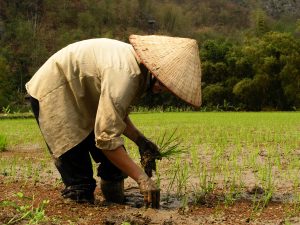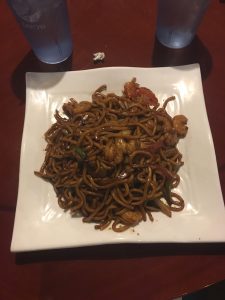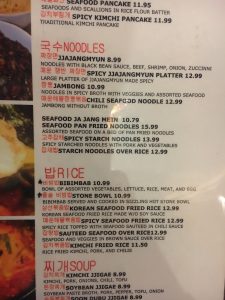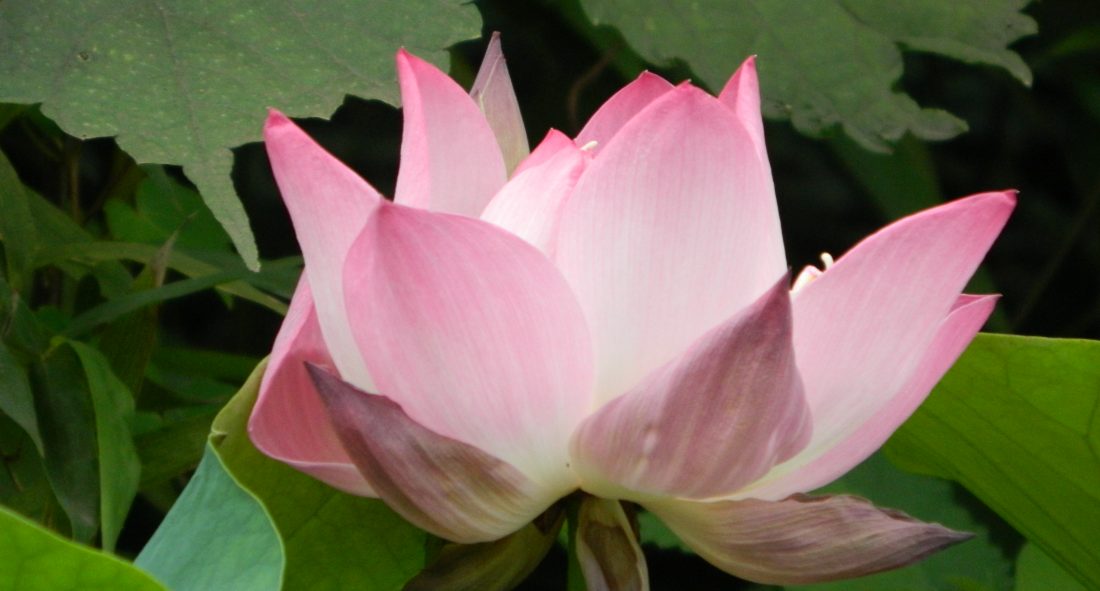By: Audrey Rotman, Betsy Morris, Katie Lee Crockett, and Alex Darras
Chin Chin, we are not in China anymore…
Although we dined at an “authentic” Chinese restaurant called Chin Chin, the food in China is prepared very differently. At Chin Chin, along with research, we discovered the Americanization of Chinese foods, especially of the two common staples, rice and noodles. Regional differences have created variation within meal preparation and typical cuisine. By eating our own “authentic” Chinese dishes, we were able to debunk the stereotypes of a true Chinese meal.
History of Rice

Rice historically stands as a native dish to southern China. The rice bowl, a metaphor for food, symbolizes well-being in general, and remains the most important cereal grain (Leppman 30). The Chinese make the rice in southern China short-grained and sticky and thus allowing easy use of chopsticks with the meal (Leppman 32). Rice continues to be a staple in the Chinese diet. Therefore, the Chinese keep a secure supply of this grain for the survival of all, rich and poor. 75% of China’s population are farmers (China: Food for a Billion Plus). The farmers play a major role in the production of rice, and if they suddenly couldn’t provide rice for the Chinese population, then people would go hungry. People serve rice at almost every meal because it brings not only Chinese people but also foreigners together.
History of Noodles

Noodles typically form a part of northern China cuisine. Corn and wheat “dominate grain farming in northern China today” (Leppman pg. 33). China’s climate didn’t originally suit the growth of wheat, but during the Han dynasty, the development of the the production of noodles helped introduce wheat into Chinese agriculture (Leppman pg. 33). During the Song dynasty (960 – 1279), “noodles made from wheat became a common staple for both the rich and poor” (Leppman pg. 34). Therefore, noodles quickly developed into a popular dish due to the appealing taste and economic benefits. Rice and noodles both grew in popularity over the years, but notable regional differences ensued early on because of natural factors like the climate (Leppman pg 33). Such “regionalization of China into rice in the south and other grains in the north [were] in place by the Han dynasty (207 B.C. to A.D. 200); that same pattern endures today” (Leppman pg. 31).
The world of noodles is diverse in its own realm. The domination of the wheat crop in northern China influences the composition of most Chinese noodles. Wheat noodles can vary in size, shape, and thickness. As we experienced at Chin Chin, lo mein is more of a spaghetti noodle as compared to Western standards. Noodles can also be made from rice crops. They are completely different from those crafted from wheat; rice noodles are “elastic, soft, and pleasant, and the flavor, though mild, is more pronounced than that of wheat noodles” (Bittman). Rice noodles are typically used in Pad Thai, another type of noodle we encountered during our dinner. Pad Thai is more popular in Thailand, its namesake, but still incorporated in Asian-American food.
Although rice and wheat have predominantly been grown in southern China, climate and agricultural patterns have changed over the past 30 years. With this change, overall grain production has slowly shifted from South China more into Central and Northern China (Veeck p. 49).
_______________________________________________________
Restaurant Exploration

We went to Chin Chin in Greenville, SC per Dr. Blumenfield’s recommendation on a Thursday night to get a taste of typical Chinese food, as well as compare rice and noodles. Two of us ordered rice dishes while the other two had noodle entrees. Chin Chin, probably one of the few Chinese restaurants in Greenville, serves authentic Chinese food. However, the restaurant itself has also been Americanized. For instance, Katie Lee ordered the Lo Mein with shrimp, but Chinese dishes do not contain shrimp at the frequency that Chinese-American dishes do.

Shrimp, a very popular dish in the United States, added an American spin to the traditional Lo Mein noodles. The menu written mostly in Characters, contains an explanation of the dish in English. Unsure of what to order, we asked the waiter for suggestions. After hearing about our project, our waiter explained the menu. He told us that these dishes would fit our needs, and we trusted that they were authentic Chinese. However, after talking with Dr. Blumenfield, we discovered that two of the dishes we ordered were Korean and Thai (Bibimbab and Pad Thai noodles, respectively). This speaks to how we as Americans have manipulated another culture’s food to our liking, disregarding their traditions and specialities. Our experience also reflects on the Americanization of Asian food, and our stereotyping when grouping Chinese, Korean, and Thai dishes together.
What We Ordered
Katie Lee ordered Shrimp Lo Mein, a popular wheat noodle dish with shrimp and a dark sauce.
Audrey ordered Shrimp Pad Thai, rice noodles that were thinly coated in a spicy sauce. The dish was served with shrimp, a more western style way of serving the noodles.


Alex ordered Spicy Chicken Fried Rice, a Chinese classic of fried rice mixed with red and green peppers, egg, chicken, and some spicy soy sauce.
Betsy ordered Bibimbab, a bowl of assorted vegetables, rice, meat, egg, and lettuce. It came with a side of sauce, which was very spicy.


While on Fall Break, Betsy visited Shun Lee Palace in Charlotte. She had the shrimp Lo Mein with white rice and soy sauce. Shun Lee Palace has been recognized for its outstanding Chinese food. They use high quality, fresh ingredients. They also do modern interpretations of classic dishes. Incorporating shrimp into Chinese dishes is a western way of preparing Chinese-American cuisine; people in China don’t use shrimp as often as Americans, as previously mentioned above.
_______________________________________________________
Restaurant Findings
The noodles that Katie Lee and Audrey ordered were quite different; the Pad Thai noodles were like linguini – thin and rectangular – while the Lo Mein noodles were tubular and thick. We also noticed how vegetables dominate Chinese meals as opposed to meat, which is more common in the United States. Since the Han dynasty, grains, accompanied with vegetables and fruits, have been the staple of the Chinese diet. (Sterckz pg. 35). After our cooking sessions with Chef Mei, we realized that most American-Chinese restaurants do not accurately represent how meals are eaten in China. Most meals in China consist of some vegetable dishes, one or two meat dishes and then everyone gets rice and/or noodles, and from all these dishes the food is shared. However in American-style Chinese restaurants, it is very uncommon to have a collection of meals that are shared by the group. Instead, dishes are more individualized and already contain the vegetables and meat with the rice and/or noodles. Because of this, it is difficult to get a true Chinese meal experience in an Chinese restaurant in the US.
_______________________________________________________
Bibliography (in case you want to know more)
Bittman, Mark, “Getting to Know the Original Pasta,” New York Times, May 17, 2000, accessed October 13, 2016.
China: Food for a Billion Plus. 2002. Accessed October 6, 2016. http://fod.infobase.com.libproxy.furman.edu/PortalPlaylists.aspx?wID=101282&xtid=35174.
Leppman, Elizabeth J. 2005. Changing Rice Bowl : Economic Development and Diet in China. Hong Kong: Hong Kong University Press, 2005. eBook Collection (EBSCOhost), EBSCOhost (accessed October 6, 2016).
Sterckz, Roel. “Food and Philosophy in Early China” In Of Tripod and Palate: food, politics, and religion in traditional China, edited by Roel, Sterckz. 34-61. New York: Palgrave MacMillan, 2005.
Veeck, Gregory, “China’s food security: past success and future challenges.” Eurasian Geography & Economics 54, no. 1 (February 2013): 42-56. Social Sciences Full Text (H.W. Wilson), EBSCOhost (accessed October 12, 2016).

The blog was really well written and organized. I really enjoyed the creativity of the titles and clearness of the posts. It was interesting learning about the different foods you went over and you were perfect in making sure to keep your readers interested without making your posts too long. Your blog was very well written and I actually wanted to continue reading the whole time. Also, I learned many things that I hadn’t known before from reading your blog, especially about rice. Here is an article: http://search.ebscohost.com.libproxy.furman.edu/login.aspx?direct=true&db=f5h&AN=3421788&site=ehost-live
I really enjoyed this blog because it had language that was informal, as a blog should be, and yet provided a lot of information that I was unaware of before reading. The set up of the paragraph lengths as well as the inclusion of a picture after every main topic proved smooth to read. I also thoroughly enjoyed the introduction and because of it being so well written, I was excited to continue reading the blog. I also like how you were all able to visit restaurants as a sort of trial and error of your blog. I understand the difficulty in ordering a non authentic meal by accident.
Here is an article discussing the differences among Authentic Chinese food and Americanized food:
http://www.attractchina.com/americanized-chinese-food-vs-authentic-chinese-food/
I really enjoyed learning more about the differences between rice and noodles and why certain regions prefer one over the other because of the differences in geography. While reading this blog I was reminded of the authentic Chinese restaurant I visited while in Vancouver. This restaurant made their noodles in house and hand cut them, which was very obvious when taking a second glance at the plates. I’m curious to known if the restaurant you visited hand cut their noodles and if this is a common practice in China. I also found the placement of photos pleasing, the way the photos were placed allowed the eye to rest on the picture, instead of reading long line after long line of text to then see the photo. One suggestion is that you could use some hyperlinks to allow readers to see more differences between the two foods or to further the information your blog holds without having to write more. Here is a link to the WSJ that talks about the personality differences between rice eaters vs noodle eaters: http://blogs.wsj.com/chinarealtime/2014/05/09/wheat-vs-rice-how-chinas-north-south-culinary-divide-shapes-personality/
One of my favorite part’s of this blog was the title and the photos. I really liked that you included the people in the photo with their dish of food which i wish my group had done. The only thing I would say you should add would be a personal description of everyone’s thoughts on the meals and more of a description of the difference between rice and noodles. For example, you could’ve described how they make the noodles.
Here’s a recipe for making hand-made chinese noodles: https://www.travelchinaguide.com/tour/food/chinese-cooking/handmade-noodles.htm
My favorite part about the blog is the title because it’s clever enough to entice readers, and clear enough to imply the content of the text. This group did a really good job on spreading out pictures and text to balance the information and not overwhelm readers. I can relate to accidentally ordering a non-authentic meal because when our group when to eat Chinese I got a teriyaki dish that apparently originated in Japan.
Here is a link to a video that shows a Chinese chef making noodles.
https://www.youtube.com/watch?v=PHoQN9vQwHE
When I read the title of this blog post, it was catchy which made me want to read it. I like how in the beginning of the blog the team acknowledged that Chinese food and Americanized Chinese food can be very different. The background of the noodles and rice were concise but effective in giving enough background. I was interested to find out the shrimp isn’t usually used in authentic Chinese cuisine because in America you usually see shrimp all over a Chinese restaurant menu. I appreciated the honestly when the group ordered a Korean dish and a Thai dish on accident, it also brought some comic relief to the blog. My few critiques would be to write a bit more about “rice vs. noodles” in the conclusion and I would love to see more up-close pictures of the food you ordered!
Here is a link to Business Insider article about Authentic Chinese Food vs. American Chinese food. http://www.businessinsider.com/authentic-chinese-food-vs-american-chinese-food-2014-7
Right, shrimp actually is used sometimes, just not in all parts of China! Please be sure to update that part.